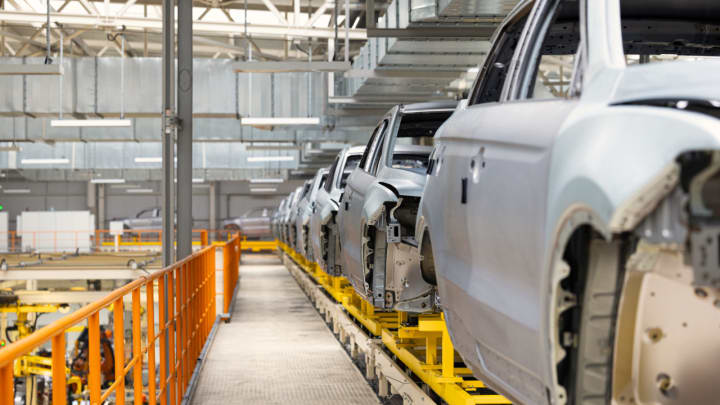Simplifying software-defined vehicles (SDVs) with EB corbos Linux – built on Ubuntu
Bertrand Boisseau
on 8 March 2024
Tags: Automotive
Carmakers are facing numerous challenges on the path towards software-defined vehicles (SDVs), such as legacy vendor dependence, which is leading to a lack of scalability, and high maintenance costs. Adopting a software-centric approach should reduce complexity and costs, accelerate time to market, improve product quality, increase flexibility, and provide more robust cybersecurity.
Carmakers need to fundamentally transform their processes and organisational structures, focusing on software development and services. Collaboration between different departments, as well as external entities, will be key in delivering exceptional products and experiences to customers. This is what highly competitive brands should be aiming for.

SDVs are the future of automotive E/E architecture. In this future, the car will be more akin to a mobile computing device. Instead of being constrained by hardware limitations, the SDV will benefit from software updates that modify their features, and enable greater adaptability and performance optimisation.
Unlocking the benefits of SDVs
As detailed in our CTO’s guide to software-defined vehicles, the SDV will reduce the complexity of vehicle architectures by simplifying the vehicular E/E hardware configurations within a vehicle. The objective is to replace multiple ECUs with fewer, more powerful components. This will lead to faster time to market, minimising engineering and development efforts that were previously required to customise, test and integrate each separate ECU. Improving quality is easier to achieve as company resources are focused on fewer items. Above all, it will lead to reduced costs.
However, just simplifying hardware is not enough to guarantee platform flexibility. The SDV is the strong layer interconnecting the different components. This software layer will act as the interface between the different components, software platforms, and networks. Ideally this should also enable OEMs to adapt to supply chain constraints, and component shortages, since the software will be adaptable to more hardware platforms.

The software-defined vehicles will make OEMs more competitive and will help them focus on creating value for the user experience, enhancing mobility services, monetising software or features, for example. In addition, the SDV helps to simplify the safety challenges. For instance, safety-proof points and reliability items can be applied on multiple types of ECUs, making fixes to potential new threats applicable to more devices.
With cybersecurity risks increasing, the next challenge facing the SDV concepts will be the demonstration that simplified software platforms reduce surface exposure while enabling additional levels of cybersecurity protection to vehicles.
A flexible and unique solution
As automotive is rapidly evolving, pushed by technologies like AD and EV, there is a need for a more flexible software platform. Elektrobit offers EB corbos Linux – built on Ubuntu, which provides a solution for secure and reliable connected vehicles, making it an ideal choice for Tier1s and OEMs that are looking to move towards Software-Defined Vehicles. With a lightweight footprint and long-term maintenance support of up to 15 years, it offers a flexible solution for automotive companies.
Elektrobit leverages the versatility of Ubuntu so that developers can use a wide range of tools, libraries and components to improve their design and testing processes. On top of that, users benefit from the stability and reliability that Canonical has provided for 20 years with the LTS release cycles of Ubuntu, and has access to regular security patches.
EB corbos Linux – built on Ubuntu, brings the best of both worlds, combining Elektrobit’s deep expertise in automotive with the open-source skills of Ubuntu and Canonical.
With regular over-the-air (OTA) updates and security patches, EB corbos Linux – built on Ubuntu, ensures that your vehicles stay secure throughout their lifecycle. This powerful and scalable OS constitutes a turnkey solution for next gen connected vehicles, combining Elektrobit’s knowledge in automotive software with the scalability of Canonical’s Ubuntu.
EB corbos Linux – built on Ubuntu also includes specific automotive features like an embedded event management and logging system, a configurable root file system initialization, as well as an SDK for development and build.

How cooperation will foster progress
EB corbos Linux – built on Ubuntu, represents a step forward towards SDV development. With Ubuntu at its core, it will greatly reduce time spent on development infrastructures, prototyping and deployment. Moreover, with proven security mechanisms and long-term support, this OS will benefit from CVE patches the same way your Ubuntu desktop does.
Elektrobit and Canonical are strongly working on this collaborative effort in order to push the industry towards SDVs with an OS that is designed specifically for current and future highly demanding automotive use cases. We are leveraging decades of experience across both software and automotive industries, to offer a combined, all-in-one solution tailored for automotive needs.
Ensure your company remains ahead in developing embedded automotive software. Try out our next generation solution and see for yourself.
Talk to us today
Interested in running Ubuntu in your organisation?
Newsletter signup
Related posts
Raising the bar for automotive cybersecurity in open source – Canonical’s ISO/SAE 21434 certification
Cybersecurity in the automotive world isn’t just a best practice anymore – it’s a regulatory imperative. With vehicles becoming software-defined platforms,...
Software development for the connected car: on the safe side with Anbox Cloud
Explore how Anbox Cloud meets the challenges of development in connected cars and automotive infotainment systems
Canonical achieves ISO/SAE 21434 certification, strengthening automotive cybersecurity standards
Certified cybersecurity processes to help safeguard next-generation connected vehicles Canonical is proud to announce it has achieved the ISO/SAE 21434...
